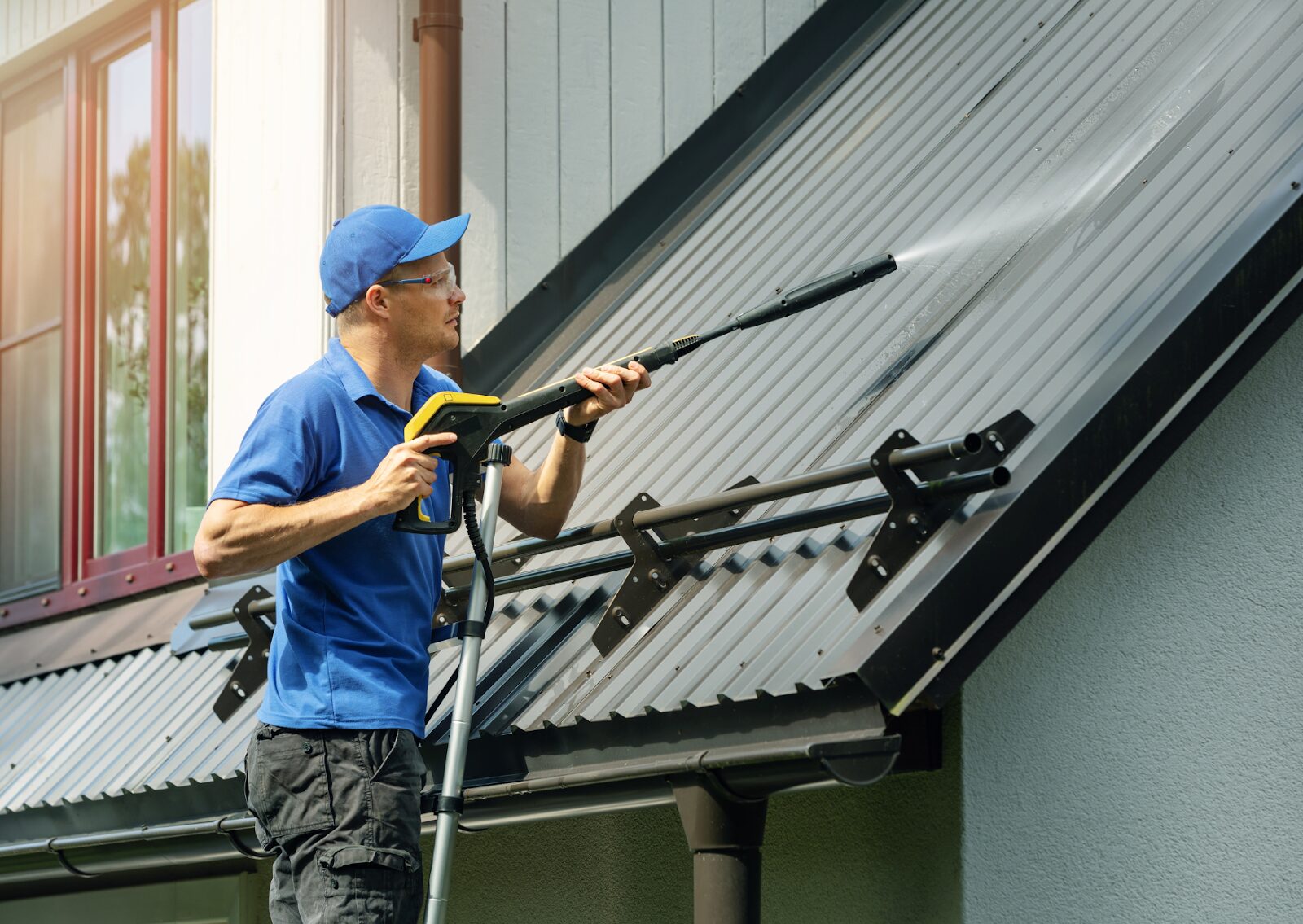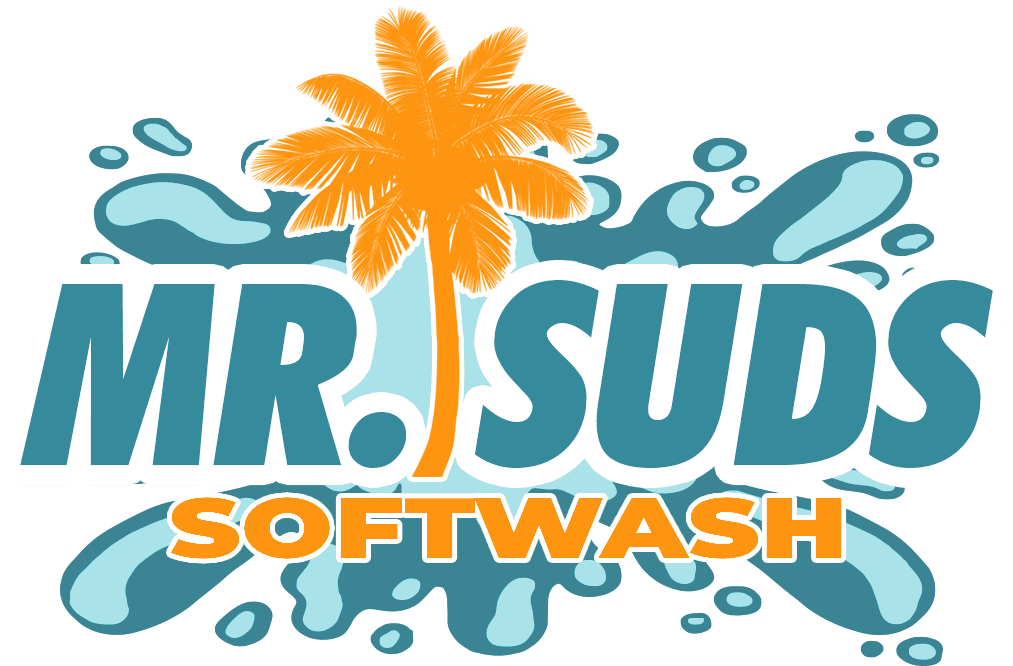Your roof does more than protect your home, it plays a big role in your home’s curb appeal and overall value. But when it comes to cleaning, many homeowners wonder if soft washing is safe or if it could harm their shingles. This guide breaks down what soft washing really is, how it compares to pressure washing, and why it’s one of the most effective methods for preserving your roof and preventing costly damage.
What Does Soft Washing a Roof Really Mean?

When homeowners ask, “Is soft washing a roof safe?” they are usually trying to understand how this cleaning method differs from the pressure washing most people know. Soft washing is a cleaning process that uses low-pressure water combined with a specialized cleaning solution to remove dirt, algae, mildew growth, and moss growth from roofing materials.
Unlike high-pressure washing or traditional power washing, this method is designed to avoid potential damage to shingles. Instead of blasting a roof surface with high-pressure water that can dislodge shingles and cause significant damage, soft wash roof cleaning uses a safe and effective method that protects asphalt shingles and other materials.
Homeowners often don’t realize that a dirty roof, stained with black streaks, moss, or other debris, can lead to more harm than just cosmetic issues. Left untreated, this build up can shorten roof lifespan and even increase energy bills due to insulation problems. Soft washing ensures your roof is well-maintained without risking damage.
Why Is Pressure Washing Risky for Your Roof?

Pressure washing has long been a common cleaning method for outdoor surfaces, but when it comes to roof cleaning, it poses serious risks. A pressure washer blasts high-pressure water at a roof surface. While it can remove dirt and debris, it often does more harm than good.
Here’s why:
- Damage shingles: High-pressure water can break seals, loosen granules, and even dislodge shingles completely.
- Potential water damage: High pressure can force water under shingles, leading to leaks.
- Voided warranties: Many manufacturers’ instructions clearly warn against pressure washing.
- Accidents: Using a pressure washer on your own roof is not only time-consuming but also dangerous, risking slips and falls.
Traditional pressure washing is better suited for sidewalks or driveways. For roofs, a safer alternative like soft washing is essential to avoid accidents and preserve your investment.
How Does Roof Cleaning Help Protect Roofing Materials?

Roof cleaning is about more than aesthetics. When you clean your roof safely and effectively, you extend the life of your roofing materials.
Soft washing helps:
- Remove moss and algae growth: Both can trap moisture and lead to water damage.
- Prevent mildew growth: Moisture buildup encourages harmful contaminants that damage shingles.
- Reduce other debris accumulation: Leaves, dirt, and other contaminants add weight and retain moisture.
- Preserve asphalt shingles: Gentle cleaning ensures they remain intact and functional.
By committing to regular roof cleaning, you avoid costly repairs and keep your roof surface in line with the manufacturer’s instructions. A clean roof means a safer home and fewer headaches down the road.
What Cleaning Method Is Best for Your Own Roof?

Choosing the right cleaning method depends on safety, effectiveness, and long-term results. While you might think about tackling your own roof with a pressure washer, the truth is this can be dangerous and often results in significant damage.
Soft wash roof cleaning is the safe and effective method most experts recommend. This cleaning process:
- Uses low-pressure water and an eco-friendly cleaning solution.
- Avoids harsh chemicals that can harm other materials.
- Safely and effectively removes black streaks, moss, and stubborn stains.
- Works as an effective method for preserving roof lifespan.
When deciding how to clean your roof, consider the difference between power washing and soft washing. One risks damaging shingles, the other safely restores a clean roof while protecting against future problems.
Why Should Regular Roof Cleaning Be Part of Roof Maintenance?

Regular roof cleaning is one of the most overlooked aspects of roof maintenance. Just like gutters need clearing, roofs need consistent care to prevent build up of dirt, moss, algae, and other debris.
Benefits of regular roof cleaning include:
- Extending the roof lifespan by preventing moss and algae from causing premature wear.
- Lowering energy bills by improving roof efficiency.
- Reducing risk of costly repairs caused by neglect.
- Preserving curb appeal by keeping the roof clean and well maintained.
Ignoring regular cleaning can result in roof damage that is both time consuming and expensive to fix. A professional roof cleaning company ensures the cleaning process is done according to the manufacturer’s instructions, giving you peace of mind.
Why Is Low Pressure Cleaning a Safer Alternative?

Low-pressure soft washing is a safer alternative because it avoids the problems caused by high pressure. Unlike high-pressure washing, which can cause potential damage, soft washing:
- Uses a chemical solution to break down algae and moss growth.
- Applies low-pressure water to rinse away contaminants safely.
- Removes stubborn stains and black streaks without risking damage.
- Ensures roofing materials remain intact and free of water damage.
A professional ensures that the cleaning solution used is both effective and eco-friendly, meaning it can remove dirt and other contaminants without exposing your roof or yard to harsh chemicals.
How Do Professional Cleaners Safely and Effectively Clean Roofs?

Professional cleaners bring expertise, equipment, and safety training that the average homeowner doesn’t have. A professional roof cleaning company uses soft wash systems that are designed to clean your roof without causing damage.
Professional roof cleaning services also:
- Follow the manufacturer’s instructions for roof maintenance.
- Use eco-friendly cleaning solutions tailored to remove moss, algae, and mildew growth.
- Ensure roofs are well-maintained by removing dirt, other debris, and contaminants.
- Avoid accidents by handling the cleaning process from start to finish.
When professional cleaners handle your roof washing, you avoid risking damage to your own roof and ensure it is cleaned according to industry standards.
How Does Roof Cleaning Improve Curb Appeal and Prevent Costly Repairs?

A clean roof not only functions better but also looks better. Roof washing removes black streaks, dirt, and other contaminants that drag down your home’s appearance. With regular roof cleaning, your home’s curb appeal increases, an important factor for both homeowners and potential buyers.
Equally important, roof cleaning helps prevent costly repairs. By removing moss, algae, and other debris, you reduce the chances of water damage and significant damage that could shorten your roof’s lifespan.
A roof that is clean, safe, and well-maintained sends the message that your home is cared for and in good condition. It’s an effective method of maintaining property value while reducing long-term costs.
Why Should You Trust Professionals Instead of Risking Damage on Your Own Roof?

Many homeowners wonder if they should clean their own roof or hire professionals. While DIY may sound appealing, the risks often outweigh the savings. A professional ensures safety, follows the cleaning method recommended for roofing materials, and helps you avoid accidents.
Trying to clean your own roof can be:
- Time-consuming and physically demanding.
- Risky in terms of falls and accidents.
- More harm than good if you use the wrong equipment.
- Costly if you end up with roof damage that requires repair.
A professional roof cleaning company provides a safer alternative, giving you a clean roof that is well-maintained without the risks of DIY.
Why Should You Choose Professional Roof Cleaning Services Today?

If you’ve been asking, “Is soft washing a roof safe?” the answer is yes, when done by professionals using the right cleaning process. Soft washing is the safe and effective method that protects shingles, preserves roof lifespan, and restores curb appeal without risking damage.
Ready to protect your home and enjoy a cleaner, safer roof? Contact Mr. Suds Softwash today for professional roof cleaning services you can trust. Get a fast quote today!
Final Thoughts
Soft washing provides a safe and effective method for roof cleaning, especially compared to traditional power washing. With low-pressure water, eco-friendly solutions, and professional cleaners who follow the manufacturer’s instructions, soft washing protects roofing materials, improves curb appeal, and prevents costly repairs.
Regular roof cleaning ensures your home remains well-maintained, your shingles stay intact, and your roof surface lasts for years to come. Choosing professional roof cleaning services is not only the safer alternative but also the smarter long-term decision for homeowners who value safety, effectiveness, and peace of mind.
Works Cited
Federal Emergency Management Agency (FEMA). Protecting Your Home or Small Business from Disasters: Nonstructural Retrofit Projects. FEMA, 2010, www.fema.gov/sites/default/files/2020-07/fema-p-804.pdf.
National Roofing Contractors Association (NRCA). “Roof System Maintenance.” NRCA, 2023, www.nrca.net/roofing/roof-system-maintenance.
Occupational Safety and Health Administration (OSHA). “Falls in Construction.” OSHA, 2023, www.osha.gov/stop-falls.
U.S. Department of Energy. “Cool Roofs.” Energy.gov, 2023, www.energy.gov/energysaver/cool-roofs.
U.S. Environmental Protection Agency (EPA). “Mold Cleanup in Your Home.” EPA, 2023, www.epa.gov/mold/mold-cleanup-your-home.
Frequently Asked Questions
1. Is soft washing a roof safe?
Yes. Soft washing is a safe and effective method that uses low pressure water and eco friendly cleaning solutions to remove dirt, algae, and moss without damaging shingles. Unlike high pressure washing, it protects roofing materials and extends the roof lifespan.
2. How often should I schedule regular roof cleaning?
Most experts recommend roof cleaning every 12 to 18 months, depending on your local climate and the amount of debris, moss, or algae growth on your roof. Regular roof cleaning prevents costly repairs and helps maintain curb appeal.
3. Can I use a pressure washer on my own roof?
It is not recommended. A pressure washer uses high pressure water that can dislodge shingles, cause roof damage, and even void manufacturer’s instructions or warranties. Professional cleaners use soft washing as a safer alternative.
4. What are the benefits of hiring professional roof cleaning services?
Professional cleaners follow safe cleaning methods, use eco friendly cleaning solutions, and ensure the cleaning process is done correctly. They also avoid accidents, remove stubborn stains, and help preserve roofing materials according to manufacturer’s instructions.
5. Does roof cleaning improve curb appeal?
Absolutely. Removing black streaks, moss, and other debris makes your roof look well maintained and dramatically improves curb appeal. A clean roof also signals that your home is cared for, which can positively impact property value.

